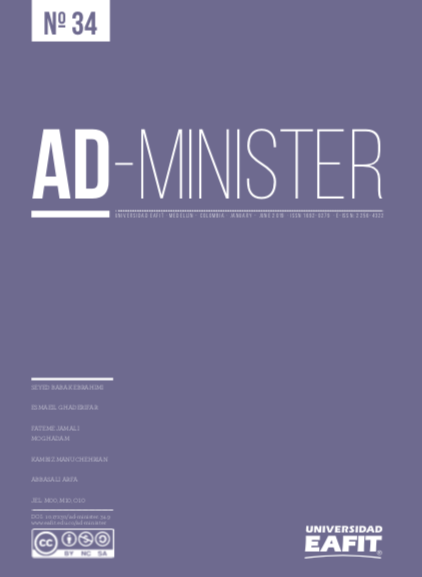Propuesta de un método para evaluar los factores de imitación de marca
Main Article Content
Keywords
imitación de marca, factores de efectividad de la imitación, TOPSIS Rough
Resumen
La imitación de marca es un enfoque para que las nuevas marcas tengan éxito en el mercado; por otro lado, puede ser destructiva para las marcas desarrolladas al incurrir en grandes pérdidas financieras. Muchos estudios han investigado la imitación y sus factores de efectividad. El presente artículo estudia los factores de efectividad de la imitación y también los clasifica a través de juicios de expertos. Usamos propiedades de números aproximados para clasificar los factores. Al hacerlo, se pidió a tres grupos de expertos, radicados en Irán, que clasificaran los factores que afectan la imitación de la marca. El proceso de clasificación fue implementado a través del método Rough-TOPSIS. Además, los autores aplican el método Fuzzy-TOPSIS y se compararon los resultados. Este estudio reconoce los factores importantes que afectan la imitación de marca y los clasifica según el nivel de significación. Los resultados enfatizan que la legislación es el factor más importante que puede prevenir la imitación de marca y la falsificación. Esta clasificación ayuda a las empresas a mejorar las especificaciones con el fin de obtener seguridad para sus marcas.
Descargas
Referencias
de Oliveira, M. O. R., et al. (2015). "Brand equity estimation model." Journal of Business Research 68(12): 2560-2568.
Dessain, S. and S. E. Fishman (2017). Chapter 7 - Porter’s Five Forces and the Market for Angel Capital. Preserving the Promise, Academic Press: 49-62.
Fazio, R. H. (1986). "How do attitudes guide behavior?" Handbook of motivation and cognition: Foundations of social behavior: 204-243.
Femke van Horen and R. Pieters (2012). "When High-Similarity Copycats Lose and Moderate-Similarity Copycats Gain: The Impact of Comparative Evaluation." Journal of Marketing Research 49(1): 83-91.
Greco, S., et al. (2001). "Rough sets theory for multicriteria decision analysis." European journal of operational research 129(1): 1-47.
Harris, P. (2007). "We the people: The importance of employees in the process of building customer experience." Journal of Brand Management 15(2): 102-114.
Keller, K. L. and K. Richey (2006). "The importance of corporate brand personality traits to a successful 21st century business." Journal of Brand Management 14(1): 74-81.
King, C. and D. Grace (2008). "Internal branding: Exploring the employee's perspective." Journal of Brand Management 15(5): 358-372.
Lai, K. K.-Y. and J. L. Zaichkowsky (1999). "Brand Imitation: Do the Chinese Have Different Views?" Asia Pacific Journal of Management 16(2): 179-192.
Le Roux, A., et al. (2016). "A typology of brand counterfeiting and imitation based on a semiotic approach." Journal of Business Research 69(1): 349-356.
Lee, C., Lee, H., Seol, H., & Park, Y. (2012). Evaluation of new service concepts using rough set theory and group analytic hierarchy process. Expert Systems with Applications, 39(3), 3404-3412.
________________________________________
Pawlak, Z. (1982). "Rough sets." International Journal of Computer & Information Sciences 11(5): 341-356.
Pawlak, Z. (1991). "Rough sets: Theoretical aspects of reasoning about data." Dordrecht: Kluwer Academic Publishing.
Scott Morton, F. and F. Zettelmeyer (2004). "The Strategic Positioning of Store Brands in Retailer–Manufacturer Negotiations." Review of Industrial Organization 24(2): 161-194.
Sinapuelas, I. C. (2007). "Essays On Me-Too Brands." PURDUE UNIVERSITY GRADUATE SCHOOL: 72.
Song, W., et al. (2013). "Risk evaluation of customer integration in new product development under uncertainty." Computers & Industrial Engineering 65(3): 402-412.
van Horen, F. and R. Pieters (2012). "Consumer evaluation of copycat brands: The effect of imitation type." International Journal of Research in Marketing 29(3): 246-255.
Van Horen, F. and R. Pieters (2013). "Preference reversal for copycat brands: Uncertainty makes imitation feel good." Journal of Economic Psychology 37: 54-64.
Walvis, T. H. (2008). "Three laws of branding: Neuroscientific foundations of effective brand building." Journal of Brand Management 16(3): 176-194.
Wilbur, K. C. and P. W. Farris (2014). "Distribution and Market Share." Journal of Retailing 90(2): 154-167.
Wu, K.-J., et al. (2012). "Using the Analytical Network Process in Porter's Five Forces Analysis – Case Study in Philippines." Procedia - Social and Behavioral Sciences 57: 1-9.
Zaichkowsky (2006). "The Psychology Behind Trademark Infringement and Counterfeiting." New Jersey: Lawrence Erlbaum Associates, Inc,.
Zhai, L.-Y., et al. (2008). "A rough set enhanced fuzzy approach to quality function deployment." The International Journal of Advanced Manufacturing Technology 37(5): 613-624.

